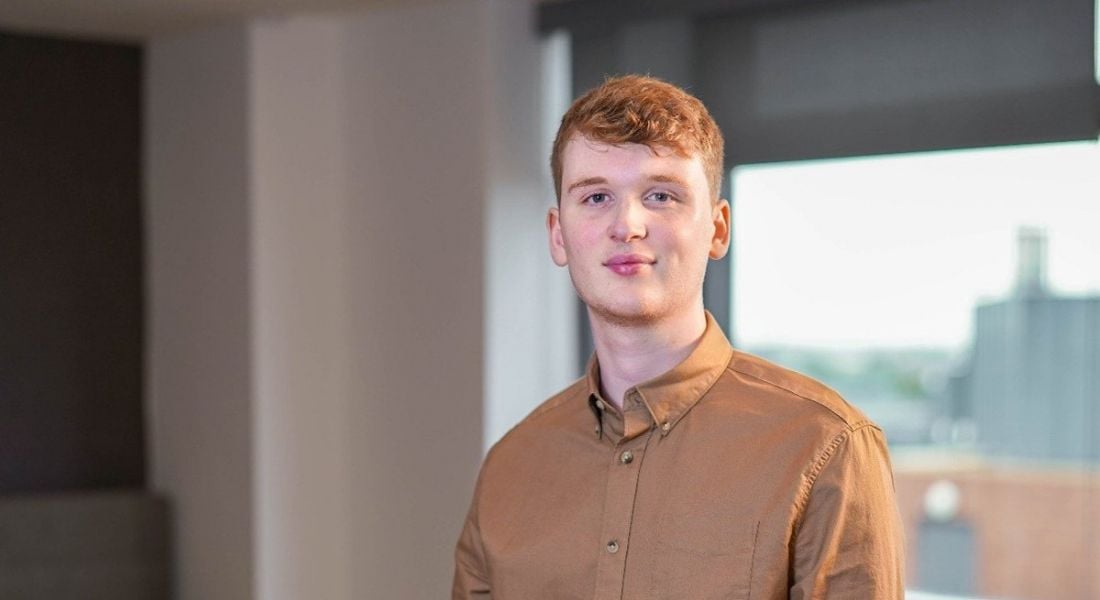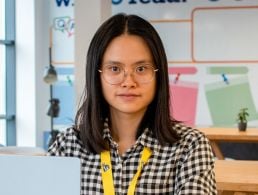EY’s Cormac Butler reflects on his experience so far on the company’s graduate programme and how his responsibilities as a data analyst have grown.
Cormac Butler’s journey through college started with an undergraduate degree in physics from Trinity College Dublin. It was during his final year there that he took a keen interest in the computational aspect of physics, which led him to pursue a master’s degree in data and computational science at University College Dublin.
“My solid foundation in mathematics and logical thinking really allowed me to hit the ground running. During my master’s, I covered topics such as programming, predictive analytics and machine learning,” he told Siliconrepublic.com.
Butler then joined the graduate programme with EY, where he is working with real-world data and helping his team tackle tough problems for a large public sector client.
“Overall, data as an industry is so dynamic and is constantly evolving. It’s a field that can add so much value now and has so much potential going forward,” he said.
‘I have had the opportunity to be exposed to new technologies and fantastic people’
– CORMAC BUTLER
What drew you to EY when you were seeking work as a graduate?
There are a few things that are important to me personally and professionally: constant growth, commitment to quality, and surrounding myself with people who are personable and down to earth. These then became the qualities I was looking for in a graduate programme.
After researching many of Ireland’s leading data analytics practices, I felt EY ticked a lot of those boxes. The data analytics practice in EY is growing at a tremendous pace, with an emphasis on expanding into new sectors and harnessing new technologies.
EY is also a global firm that works with global clients so I knew I would have the opportunity to work on some big and exciting projects.
Ultimately, the deciding factor which led to me accepting the offer was the welcoming and relatable demeanour of the people I interacted with during my research and interview process.
What expectations did you have before you began the programme?
I knew I would be performing some elements of data analysis, engineering and visualisation. The largest uncertainty I had was how I would acclimatise to corporate work as someone who had no experience in a large private sector analytics practice.
Fortunately, when I started everyone was very welcoming and supportive. The project I joined is a close-knit team where professional and personal growth is actively supported.
What duties and responsibilities where you given initially?
In the first month, I was placed directly onto a project with a major public sector client. My first task was to read the documentation and familiarise myself with the relevant parts of the code base. I was also shadowing more senior team members, ensuring I asked as many questions as possible.
My initial tasks mostly comprised data validation and quality assurance automation, allowing me to gain a firm grasp of the technical side of the project. The learning curve at the start was quite steep, as with every new piece I’ve been assigned.
Has the scope of your work changed as the programme progressed?
Yes, it’s changed a few times. After a few months on the project I transitioned into a model development and data visualisation role.
More recently I have been taking the lead on aspects of data engineering, working closely with the modelling and visualisation teams to ensure all the correct assumptions are reflected in the data.
Can you describe a typical day in your role?
Each day starts with a daily stand-up where the team discusses priorities for the day, reviews timelines and raises any issues or development blockers. Usually there will also be a meetings during the day on designing more specific development requirements.
The bulk of the day is made up of coding and developing the inputs, and modelling improvements for our digital twin model.
It’s a difficult task to model some of the complex behaviours associated with this project but we have some very technically strong team members as well as analytics professionals who have a range of specialisms we can draw on.
I also always try to add in some time during the day to catch up with colleagues and ensure I stay connected to the wider team.
How do your responsibilities compare to more experienced employees’?
Since joining EY, I have taken on a huge amount of responsibility and have been entrusted with many mission-critical tasks that the more experienced employees are also given. This level of trust has really allowed me to develop rapidly.
Senior team members also take on the additional roles of project management, carry out more client-facing work and coach junior members of the team. These are all activities I am regularly exposed to but only compose a small fraction of my role.
Do you feel more prepared for working life after participating in this programme?
Having completed one year in the project so far, I think I’m happy with how I’ve developed professionally and personally. I have had the opportunity to be exposed to new technologies and fantastic people – all things that will hopefully really accelerate the rest of my career. I think one thing that has really helped me build confidence is saying yes to new opportunities – including this interview.
Why should someone apply to the graduate programme at EY?
Data analytics at EY is a fast-paced environment with a friendly and supportive culture. The people here are from diverse backgrounds, whether it be data engineering, data science or data visualisation/storytelling, so there are roles here for everyone.




